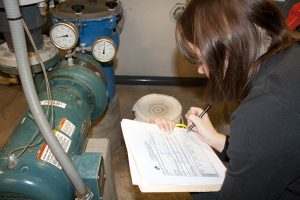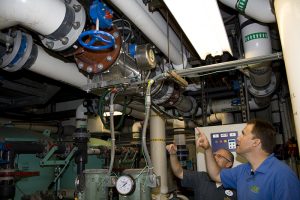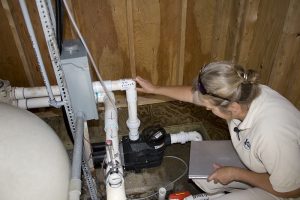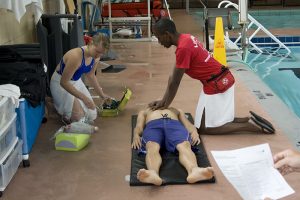For all pool and spa professionals, maintaining a safe workplace for both staff and the general public is the ultimate goal, one that can be best achieved by conducting regular facility audits. Audits can significantly impact how an organization prevents, prepares for and responds to emergencies, and they are an integral component of any risk management plan. In fact, a facility audit is arguably the most important task an organization can perform.
Whether you are a facility manager, service professional, consultant, builder or retailer, audits should be a regularly scheduled activity. On-site audits assist managers in the development of operational and emergency response plans, including appropriate documentation, maintenance strategies and ways to improve operational and staff management and training. Audits may also identify potential emergencies that assist a facility in developing an emergency response plan.
Management personnel have a responsibility to either conduct self-audits or to hire a qualified consultant to perform them. Those who conduct the audits should make recommendations for corrective action, and should be empowered to conduct followup inspections to ensure those actions are taken.
While these concepts are not new to the pool and spa industry, properly conducting them still requires a clear understanding of their purpose and processes.
Audit objectives and scope
The first step when conducting an audit is setting objectives to evaluate current operational practices and identify areas where safety improvements can be made. The result should be recommendations that mitigate problem areas.
Regardless of facility size, it is essential to identify the scope of an audit before proceeding. Answering a few basic questions will help to determine the nature, extent and formality of a given audit. For example:
- What kind of audit is being conducted?
- What knowledge, reference information and supplies will be required during the audit?
- What qualifications should the auditor have?
- What items should be included on the audit checklist?
- Who or what facilities, operations or areas will be audited?
- Who in or outside the organization will be conducting the audit?
- When and how will the audit be carried out?
- Who in the organization should receive audit results and/or a formal report?
Prior audits and injury and illness reports may establish a precedent for the upcoming audit. They may also guide the auditor to learn if previous recommendations have been implemented.
Conducting the audit
When deciding on what type of audit to perform, develop a checklist that can be used during the actual audit. This can serve as a template for future audits, allowing auditors to add or delete items depending on the specifics of the inspection. There are several resources that can help with checklist development. Company hazard communication plans, local codes, chemical storage guidelines, municipal, provincial and federal laws and international standards are good starting points. Employees may also suggest other checklist items based on safety training, trade shows or their own independent research.

When deciding on what type of audit to perform, development of a checklist is a helpful tool.
A facility auditor must be able to recognize and make recommendations to remove or reduce exposure hazards. He or she should verify whether employees are following safety procedures, are able to perform their job responsibilities and can respond appropriately to emergency situations. For example, lifeguard audits at an aquatic facility will demonstrate the employees’ ability to perform rescues and administer aid to a victim, while also verifying all staff have completed the necessary certifications and training for their respective jobs. Similarly, a builder should verify that employees or subcontractors use appropriate personal protective equipment (PPE).
It is also important to ensure the facility, equipment and operations meet the required local and federal health and safety requirements, as well as best industry business practices. In addition, audits make certain that proper records supporting the required health, safety and medical activities are maintained.
Reporting the audit results

The location and description of each hazard should be noted in sufficient detail, including the location, name of department areas, date and time of the audit.
Be specific about the hazards identified. The location and description of each hazard should be noted in sufficient detail, including the location, name of department areas, date and time of the audit. Including these specifics is helpful, as it will make it easier to carry out the specified corrective action. Digital photographs can also be included in a report to clarify written observations.
For instance, instead of merely noting the presence of a generic hazard (e.g. ‘fire hazard’), a facility audit report should provide more details, for example:
- frayed wire on hand drill number 237;
- flammable material underneath table in area 5;
- liquid water clarifiers stored above National Fire Protection Association (NFPA) Class 1 solid oxidizer chemicals on storage shelf; or
- delivery personnel from Company X were not using appropriate back braces when unloading pallets to storage room during delivery.
When documenting hazards, the report should also detail what needs to be done to correct them; it may also identify who is responsible for taking the corrective action. To the best of the auditor’s ability, the report should highlight audit results and corrective actions in order of severity. This helps ensure the most pressing matters are dealt with first.

If the water came from a leaking pipe, it is important the leak be repaired to prevent a more serious water problem.
For example, wiping up a wet area on the floor removes the immediate problem but does not remove the cause. If the water came from a leaking pipe, it is important the leak be repaired to prevent a more serious water problem.
If the hazard poses an immediate and dangerous threat to workers or the public, the facility or area must be closed until the necessary corrective steps have been taken to eliminate it. In some cases, a temporary corrective action must be taken to prevent accidents until a permanent solution can be implemented—for example, roping off the affected area, tagging and locking out equipment or posting warning signs. This will control exposure to the hazard until it can be minimized or eliminated.
Emergency response planning
While audits play an important role in identifying and minimizing risks, they cannot completely prevent accidents from happening. Circumstances in the workplace can change and employees should be prepared to respond to a variety of emergencies including:
- severe weather;
- fire;
- head and neck injuries (to the public or employees);
- anger or threats of violence (from the public or employees); and
- worker injuries or medical emergencies (e.g. chemical exposure accidents, cuts, lacerations, heart attack, etc.).
Every employer has a duty to outline emergency response procedures in their organization’s emergency response plan (ERP); employees have the responsibility to follow it. Every person needs to know what is required in the ERP and their individual accountability regarding its execution. Proper training is critical to the health and safety of all employees, visitors and customers.
Creating an emergency response plan
ERPs are written documents, kept at the workplace, and made available to all employees. There are several factors that must be taken into consideration when designing an ERP. These include the facility layout, the number of employees on duty, auxiliary staff available at the facility, hazards in and around the facility and type of patrons using the facility.
Before implementing an ERP, an employer must designate and train a sufficient number of people to assist in the safe and orderly emergency evacuation of employees. An ERP must include emergency escape procedures, escape routes and measures to account for all employees after the evacuation has occurred. Normally, employees are assigned to report to a designated assembly area where they can be accounted for.
An ERP must also detail procedures to be followed by employees who are performing critical operations at the time an evacuation occurs. The plan should list the personnel designated to assist in medical and rescue duties, along with instructions on the preferred means of reporting fires and other emergencies.
An ERP should also include the names, job titles and contact information for each employee. The employer should review the plan with all staff members when it is initially developed and any time any changes are made.
Responsive action

Lifeguard audits will demonstrate an employee’s ability to perform rescues and administer aid (e.g. CPR) to a victim.
In any emergency, communication is essential. Lifeguards can communicate using different methods such as hand signals, whistles, telephones and walkie-talkies (radio). Employees can call for help by dialing 911. The telephone or walkie-talkie can provide a staff member with immediate access to the manager and other vital employees, allowing them to converse as a group while organizing a quick response. The walkie-talkie also allows mobility, which is important in a crisis.
Emergency situations may also generate media coverage. An organization’s emergency response plan should outline who is designated to speak with the media, including guidance on what to say (and not say).
Bringing it all together
Conducting audits and developing ERPs should not be taken lightly. Too often organizations play a game of chance, hoping nothing will happen at their facilities. Most of the time, they are lucky. Yet, when an employee or guest is injured, made ill or dies as a result of an emergency situation, tremendous pain and suffering is the result. In addition, financial and liability consequences can be devastating to the organization. Regularly scheduled facility audits and development of an ERP will protect employees, customers and stakeholders.
This article was written by Alex Antoniou, PhD, Thomas M. Lachocki, PhD and Laurie Batter, and originally appeared on Pool & Spa Marketing [link].
